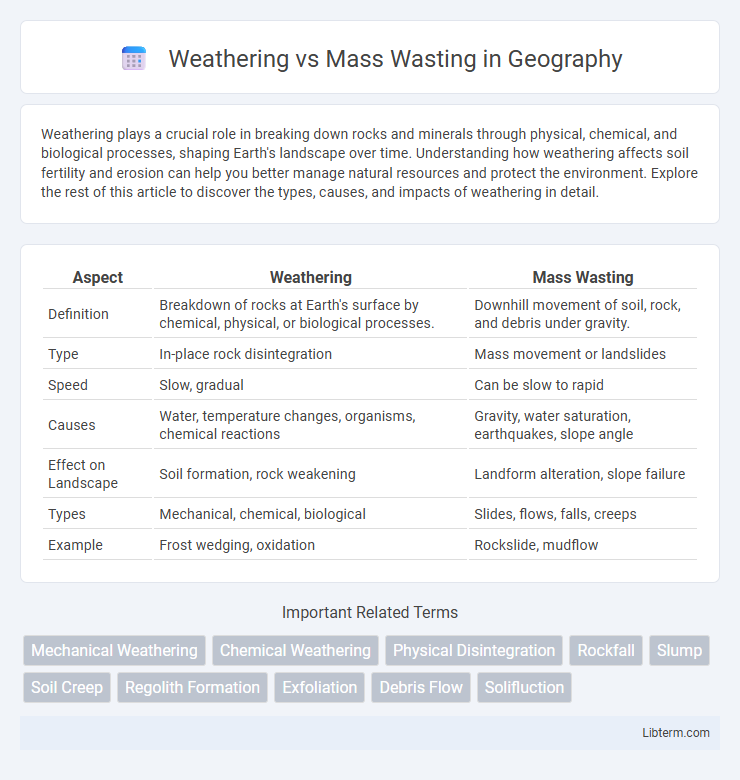Weathering plays a crucial role in breaking down rocks and minerals through physical, chemical, and biological processes, shaping Earth's landscape over time. Understanding how weathering affects soil fertility and erosion can help you better manage natural resources and protect the environment. Explore the rest of this article to discover the types, causes, and impacts of weathering in detail.
Table of Comparison
| Aspect | Weathering | Mass Wasting |
|---|---|---|
| Definition | Breakdown of rocks at Earth's surface by chemical, physical, or biological processes. | Downhill movement of soil, rock, and debris under gravity. |
| Type | In-place rock disintegration | Mass movement or landslides |
| Speed | Slow, gradual | Can be slow to rapid |
| Causes | Water, temperature changes, organisms, chemical reactions | Gravity, water saturation, earthquakes, slope angle |
| Effect on Landscape | Soil formation, rock weakening | Landform alteration, slope failure |
| Types | Mechanical, chemical, biological | Slides, flows, falls, creeps |
| Example | Frost wedging, oxidation | Rockslide, mudflow |
Introduction to Weathering and Mass Wasting
Weathering involves the physical and chemical breakdown of rocks at or near Earth's surface, producing smaller particles and soil essential for ecosystem development. Mass wasting refers to the downhill movement of rock, soil, and debris under the influence of gravity, occurring in forms such as landslides, rockfalls, and creep. Both processes play critical roles in landscape evolution, with weathering weakening materials that are later mobilized by mass wasting events.
Defining Weathering: Processes and Types
Weathering involves the physical, chemical, and biological processes that break down rocks and minerals at Earth's surface without movement. It includes mechanical weathering, such as freeze-thaw cycles and abrasion, and chemical weathering, where reactions with water, oxygen, and acids alter mineral composition. Biological weathering results from organisms like plant roots and microbes accelerating rock disintegration.
Mechanical vs Chemical Weathering
Mechanical weathering breaks down rocks into smaller pieces through physical forces like freeze-thaw cycles, abrasion, and thermal expansion, without changing the rock's chemical composition. Chemical weathering alters the mineral structure of rocks through reactions with water, oxygen, acids, and other chemicals, leading to the formation of new minerals and weakening of rock integrity. Mass wasting involves the downslope movement of rock and soil driven by gravity, often influenced by both mechanical and chemical weathering that destabilize slopes.
Mass Wasting: An Overview
Mass wasting is the downslope movement of soil, rock, and debris driven primarily by gravity, varying in speed from slow creep to rapid landslides. Key factors influencing mass wasting include slope angle, water content, vegetation cover, and geological material characteristics. Common types of mass wasting are rockfalls, slides, flows, and slumps, each posing significant risks to landscapes and human infrastructure.
Key Factors Influencing Weathering
Key factors influencing weathering include climate, rock type, and time. Temperature fluctuations and moisture levels accelerate chemical and physical weathering processes, while rock mineral composition determines susceptibility to breakdown. The duration of exposure enhances the extent of weathering, shaping soil formation and landscape evolution.
Triggers and Causes of Mass Wasting Events
Mass wasting events are primarily triggered by factors such as intense rainfall, rapid snowmelt, earthquakes, volcanic activity, and human disturbances like deforestation or construction. Saturation of soil due to prolonged precipitation reduces cohesion, increasing the risk of landslides and debris flows. Steep slopes and unstable geological formations further amplify susceptibility to mass wasting, distinguishing it from slower, surface-level weathering processes.
Comparative Analysis: Weathering vs Mass Wasting
Weathering is the gradual breakdown of rocks through chemical, physical, or biological processes, altering rock composition and structure, whereas mass wasting involves the rapid or slow downslope movement of soil and rock under the influence of gravity. Weathering acts as a preparatory process that weakens material, increasing susceptibility to mass wasting events like landslides, debris flows, and rockfalls. The key difference lies in weathering being a surface-altering mechanism over time, while mass wasting constitutes actual material displacement shaping landscapes.
Environmental Impacts of Weathering and Mass Wasting
Weathering contributes to soil formation and nutrient cycling, supporting ecosystems, but excessive chemical weathering can lead to soil degradation and water pollution. Mass wasting causes rapid landscape changes, resulting in habitat destruction, sedimentation in waterways, and increased flood risks. Both processes influence sediment transport affecting aquatic ecosystems and can exacerbate environmental hazards in vulnerable regions.
Human Activities and Their Effects
Human activities such as deforestation, construction, and mining accelerate weathering by exposing soil and rock surfaces to atmospheric conditions, leading to increased chemical and physical breakdown. Urbanization and land-use changes often destabilize slopes, intensifying mass wasting events like landslides and mudflows. These anthropogenic factors contribute to soil erosion, loss of fertile land, and increased sedimentation in waterways, impacting ecosystems and infrastructure.
Mitigation and Prevention Strategies
Mitigation and prevention strategies for weathering involve applying protective coatings, controlling moisture exposure, and using resistant materials to slow the chemical and physical breakdown of rocks. Mass wasting prevention focuses on stabilizing slopes through retaining walls, terracing, vegetation planting, and drainage control to reduce soil erosion and landslide risks. Monitoring early warning signs and implementing engineered structures significantly reduce the impacts and frequency of mass wasting events.
Weathering Infographic

 libterm.com
libterm.com